Carbonation-Induced Corrosion Initiation Probability of Rebars in Concrete With/Without Finishing Materials
Abstract
:1. Introduction
1.1. Carbonation Prediction Equation
1.2. Probabilistic Carbonation Assessment
2. Methods and Materials
2.1. Overview of Construction Site and Accelerated Experiment
2.2. Measurement of Concrete Cover Thickness at On-Site
2.3. Accelerated Carbonation Experiment in Laboratory
3. Results and Discussion
3.1. Site Survey of Concrete Cover Thickness
3.2. Accelerated Carbonation Experiment in the Laboratory
3.2.1. Carbonation Depth Measurement
3.2.2. Carbonation Coefficient Calculation
3.2.3. Carbonation Ratio Measurement
3.2.4. Carbonation Progress Prediction Model
3.3. Probabilistic Carbonation Assessment
4. Conclusions
- (1)
- The thickness of the concrete cover throughout the on-site buildings was maintained under the limit (±10 mm).
- (2)
- Silk wallpaper is the best among all finishing materials, and it reduced the carbonation depth and coefficient by half compared to plain OPC owing to its function as a strong external physical barrier for the penetration of CO2 in concrete.
- (3)
- Silk wallpaper finishing material exhibited the minimum carbonation depth in the accelerated conditions after 1 and 13 weeks of exposure while WP and plain OPC exhibited approximately identical values.
- (4)
- The carbonation depth prediction model showed that 40 years is required for plain OPC while for SWP, it was expected that carbonation would not reach the rebar position even after 100 years.
- (5)
- Finally, the accelerated carbonation experiment showed that 30% of the onset rebar corrosion would begin after 51 years for plain OPC, and 200 years for SWP.
Supplementary Materials
Author Contributions
Funding
Conflicts of Interest
References
- Golewski, G.L. Generalized Fracture Toughness and Compressive Strength of Sustainable Concrete Including Low Calcium Fly Ash. Materials 2017, 10, 1393. [Google Scholar] [CrossRef] [PubMed]
- Golewski, G.L. Improvement of fracture toughness of green concrete as a result of addition of coal fly ash. Characterization of fly ash microstructure. Mater. Charact. 2017, 134, 335–346. [Google Scholar] [CrossRef]
- Golewski, G.L. Green concrete composite incorporating fly ash with high strength and fracture toughness. J. Clean. Prod. 2018, 172, 218–226. [Google Scholar] [CrossRef]
- Pacheco-Torgal, F.; Miraldo, S.; Labrincha, J.A.L.; De Brito, J. An overview on concrete carbonation in the context of eco-efficient construction: Measurement, use of SCM´s and/or RCA. Constr. Build. Mater. 2012, 36, 141–150. [Google Scholar] [CrossRef] [Green Version]
- Saha, M.; Eckelman, M. Urban scale mapping of concrete degradation from projected climate change. Urban Clim. 2014, 9, 101–114. [Google Scholar] [CrossRef]
- Lee, H.-S.; Wang, X.-Y. Evaluation of the Carbon Dioxide Uptake of Slag-Blended Concrete Structures, Considering the Effect of Carbonation. Sustainability 2016, 8, 312. [Google Scholar] [CrossRef]
- Peng, L.; Stewart, M.G. Climate change and corrosion damage risks for reinforced concrete infrastructure in China. Struct. Infrastruct. Eng. 2016, 12, 499–516. [Google Scholar] [CrossRef]
- Yang, K.-H.; Singh, J.K.; Lee, B.-Y.; Kwon, S.-J. Simple Technique for Tracking Chloride Penetration in Concrete Based on the Crack Shape and Width under Steady-State Conditions. Sustainability 2017, 9, 282. [Google Scholar] [CrossRef]
- Basheer, L.; Kropp, J.; Cleland, D.J. Assessment of the Durability of Concrete from its Permeation Properties: A Review. Constr. Build. Mater. 2001, 15, 93–103. [Google Scholar] [CrossRef]
- Papadakis, V.G.; Vayenas, C.G.; Fardis, M.N. Physical and chemical characteristics affecting the durability of concrete. ACI Mater. J. 1991, 88, 186–196. [Google Scholar]
- Aguiar, J.B.; Júnior, C. Carbonation of surface protected concrete. Constr. Build. Mater. 2013, 49, 478–483. [Google Scholar] [CrossRef] [Green Version]
- Bentur, A.; Diamond, S.; Berke, N.S. Steel Corrosion in Concrete; CRC Press: London, UK, 1997; p. 158. ISBN 9781482271898. [Google Scholar]
- Alonso, C.; Andrade, C.; Gonz´alez, J.A. Relation between resistivity and corrosion rate of reinforcements in carbonated mortar made with several cement types. Cem. Concr. Res. 1988, 18, 687–698. [Google Scholar] [CrossRef]
- Anstice, D.J.; Page, C.L.; Page, M.M. The pore solution phase of carbonated cement pastes. Cem. Concr. Res. 2005, 35, 377–383. [Google Scholar] [CrossRef]
- Chi, J.M.; Huang, R.; Yang, C.C. Effects of carbonation on mechanical properties and durability of concrete using accelerated testing method. J. Mar. Sci. Technol. 2002, 10, 14–20. [Google Scholar]
- Bier, T.; Kropp, J.; Hilsdorf, H. Formation of silica gel during carbonation of cementitious systems containing slag cements. In Proceedings of the 3rd International Conference: Fly Ash, SilicaFume, Slag and Natural Pozzolans in Concrete, Trondheim, Norway; American Concrete Institute: Farmington Hills1, MI, USA, 1989. [Google Scholar]
- Bouchaala, F.; Payan, C.; Garnier, V.; Balayssac, J.P. Carbonation assessment in concrete by nonlinear ultrasound. Cem. Concr. Res. 2011, 41, 557–559. [Google Scholar] [CrossRef]
- Dias, W.P.S. Reduction of concrete sorptivity with age through carbonation. Cem. Concr. Res. 2000, 30, 1255–1261. [Google Scholar] [CrossRef]
- Verbeck, G. Carbonation of hydrated Portland cement. ASTM Spec. Tech. Publ. 1958, 205, 17–36. [Google Scholar]
- Hansson, C.M. Comments on electrochemical measurements of the rate of corrosion of steel in concrete. Cem. Concr. Res. 1984, 14, 574–584. [Google Scholar] [CrossRef]
- Pourbaix, M. Atlas of Electrochemical Equilibria in Aqueous Solution; Pergamon Press: Oxford, NY, USA, 1966; pp. 307–321. [Google Scholar]
- Huang, N.M.; Chang, J.J.; Liang, M.T. Effect of plastering on the carbonation of a 35-year-old reinforced concrete building. Constr. Build. Mater. 2012, 29, 206–214. [Google Scholar] [CrossRef]
- Park, K.-B.; Wang, X.-Y. Effect of Climate Change on Service Life of High Volume Fly Ash Concrete Subjected to Carbonation—A Korean Case Study. Sustainability 2017, 9, 157. [Google Scholar] [CrossRef]
- Jiang, C.; Gu, X.; Huang, Q.; Zhang, W. Carbonation depth predictions in concrete bridges under changing climate conditions and increasing traffic loads. Cem. Concr. Compos. 2018, 93, 140–154. [Google Scholar] [CrossRef]
- Kishitani, K.; Kobayashi, K.; Kashino, N.; Uno, Y. The Relationship between Rebar Corrosion and Neutralization in the Concrete Containing Chloride. Concr. Res. Technol. 1991, 2, 77–84. [Google Scholar] [CrossRef]
- Architectural Institute of Japan. Recommendations for Durability Design and Construction Practice of Reinforced Concrete Buildings, 2nd ed.; Architectural Institute of Japan: Tokyo, Japan, 2016; pp. 15–260. ISBN 9784818910751. [Google Scholar]
- Thiery, M.; Cremona, C.; Baroghel-Bouny, V. Application of the reliability theory to the assessment of carbonation-induced corrosion risk of rebars. Eur. J. Environ. Civ. Eng. 2012, 16, 273–287. [Google Scholar] [CrossRef]
- Papadakis, V.; Vayenas, C.; Fardis, M. A reaction engineering approach to the problem of concrete carbonation. AlChE J. 1989, 35, 1639–1650. [Google Scholar] [CrossRef]
- Bakker, R. Model to Calculate the Rate of Carbonation in Concrete under Different Climatic Conditions; CMIJ bv Laboratorium: Imuiden, The Netherlands, 1993. [Google Scholar]
- Lee, H.M.; Lee, H.S.; Singh, J.K. Prediction Model for the Carbonation of Post-Repair Materials in Carbonated RC Structures. Materials 2017, 10, 492. [Google Scholar] [CrossRef]
- Izumi, N.; Fumio, S. Neutralization of concrete and corrosion of reinforcing bars in aged buildings. J. Struct. Constr. Eng. 1989, 406, 1–12. [Google Scholar]
- Köliö, A.; Honkanen, M.; Lahdensivu, J.; Vippola, M.; Pentti, M. Corrosion Products of Carbonation Induced Corrosion in Existing Reinforced Concrete Facades. Cem. Concr. Res. 2015, 78, 200–207. [Google Scholar] [CrossRef]
- Roy, S.K.; Northwood, D.O.; Poh, K.B. Effect of plastering on the carbonation of a 19-year-old reinforced concrete building. Constr. Build. Mater. 1996, 10, 261–272. [Google Scholar] [CrossRef]
- Park, D.C. Carbonation of concrete in relation to CO2 permeability and degradation of coatings. Constr. Build. Mater. 2008, 22, 2260–2268. [Google Scholar] [CrossRef]
- Frédéric, D.; Ngoc, T.V.; Alain, S. Accelerated carbonation tests for the probabilistic prediction of the durability of concrete structures. Constr. Build. Mater. 2014, 66, 597–605. [Google Scholar] [CrossRef]
- KS F 2596: Korea Industrial Standards. In Method for Measuring Carbonation Depth of Concrete; Korean Standards & Certification Information Center: Seoul, Korea, 2004; pp. 1–7.
- KS F 2584-2010: Standard Test Method for Accelerated Carbonation of Concrete; Korean Standards & Certification Information Center: Seoul, Korea, 2010.
- Korea Concrete Institute. Korean Concrete Standard; Korea Concrete Institute: Seoul, Korea, 2009; Volume 81. [Google Scholar]
- Sci´slewski, Z. Protection of Reinforced Constructions; Arkady: Warszawa, Poland, 1999. [Google Scholar]
- Łakomy, T. Corrosion of Reinforcement in Bridges Depending on Concrete Condition in Structure. Ph.D. Thesis, Warsaw University of Technology, Warsaw, Poland, 2009. [Google Scholar]

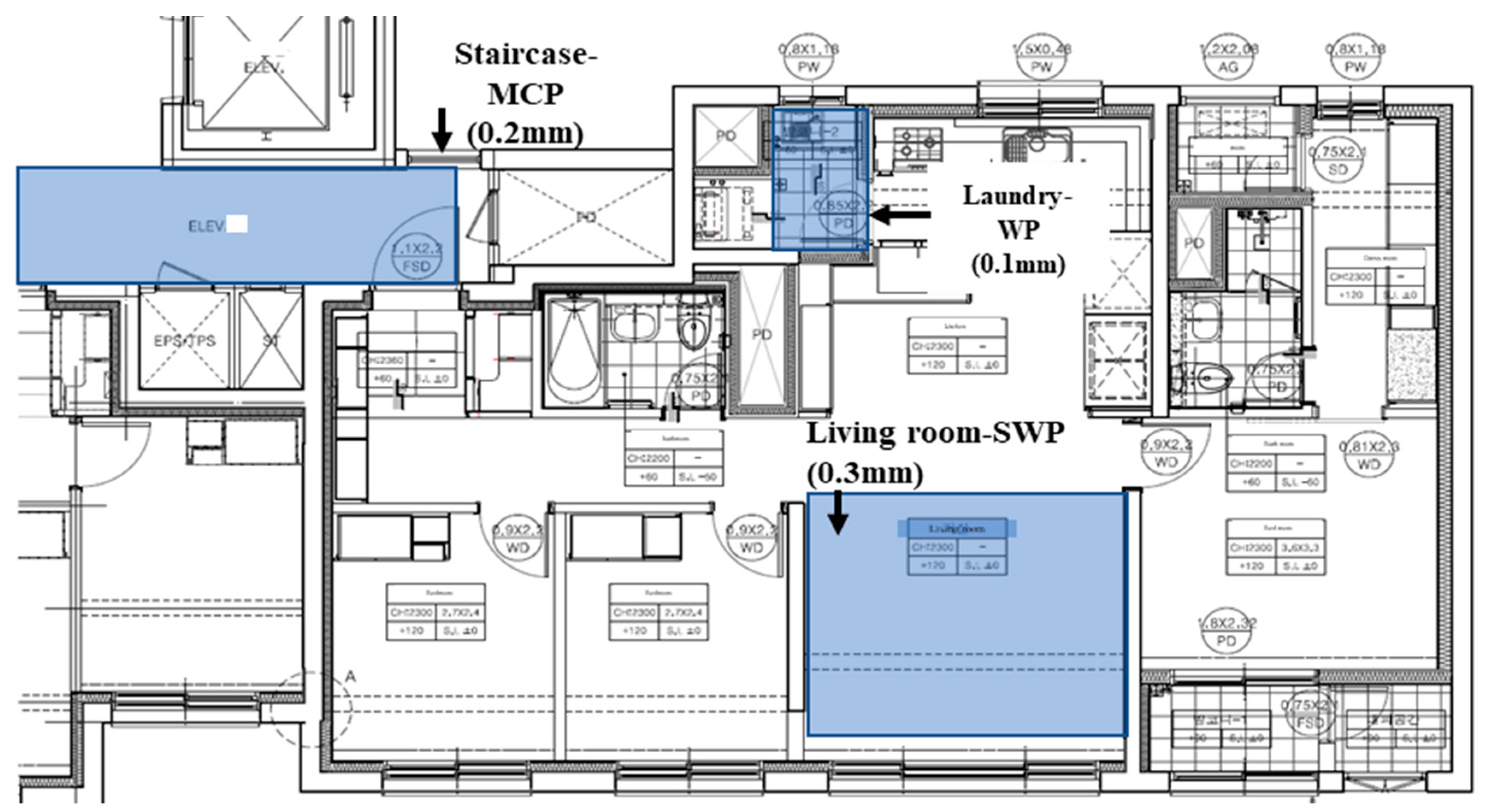
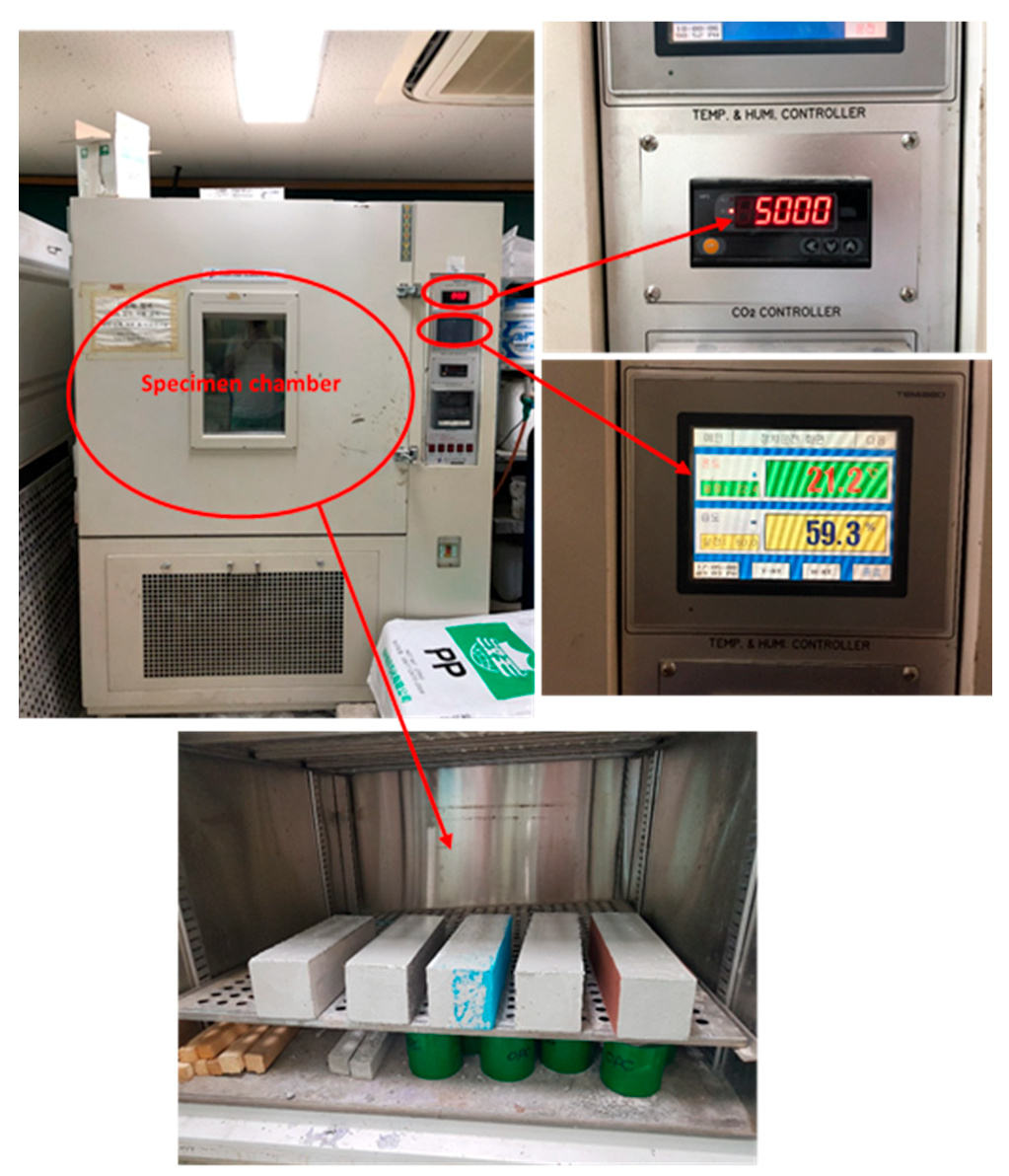
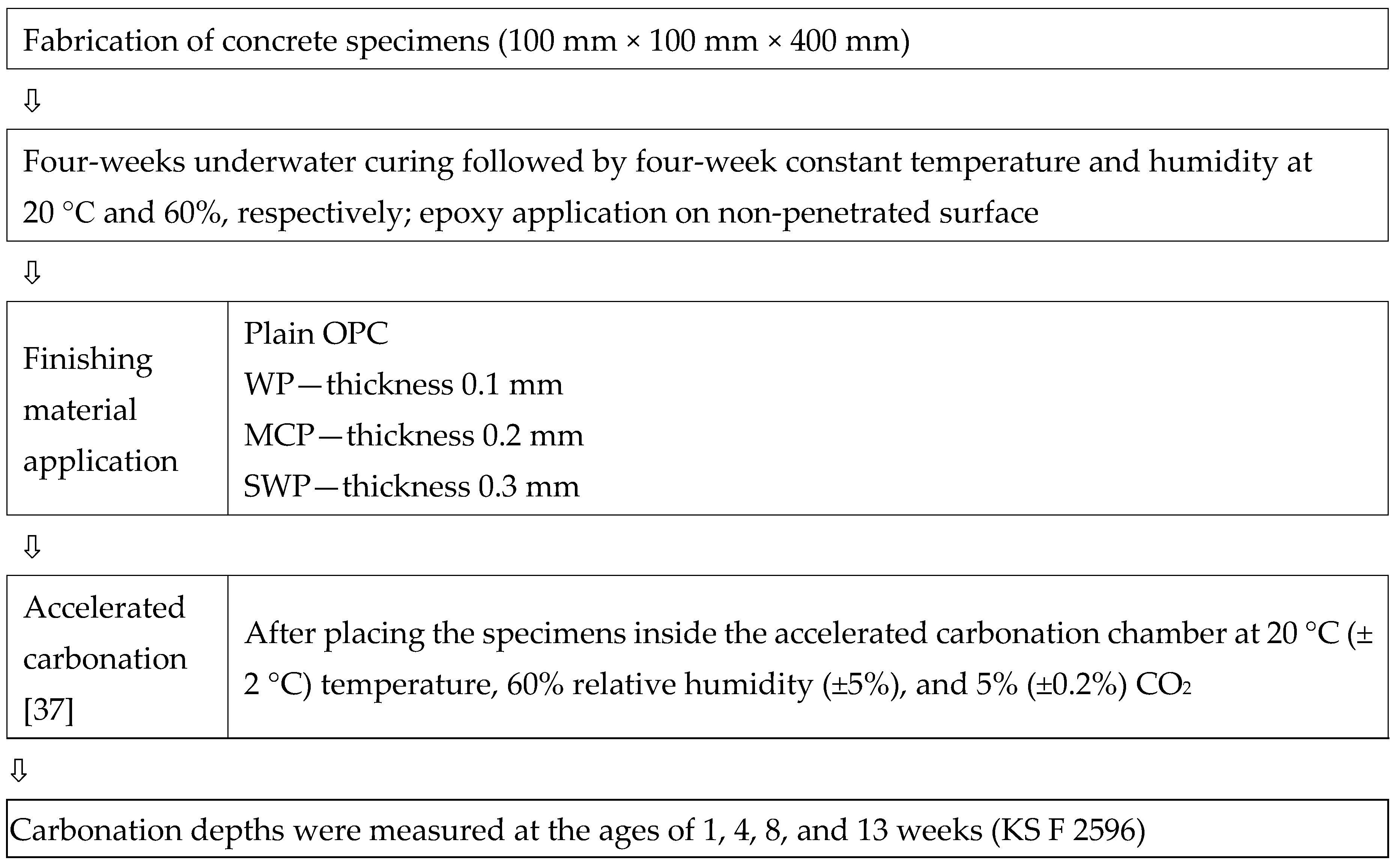
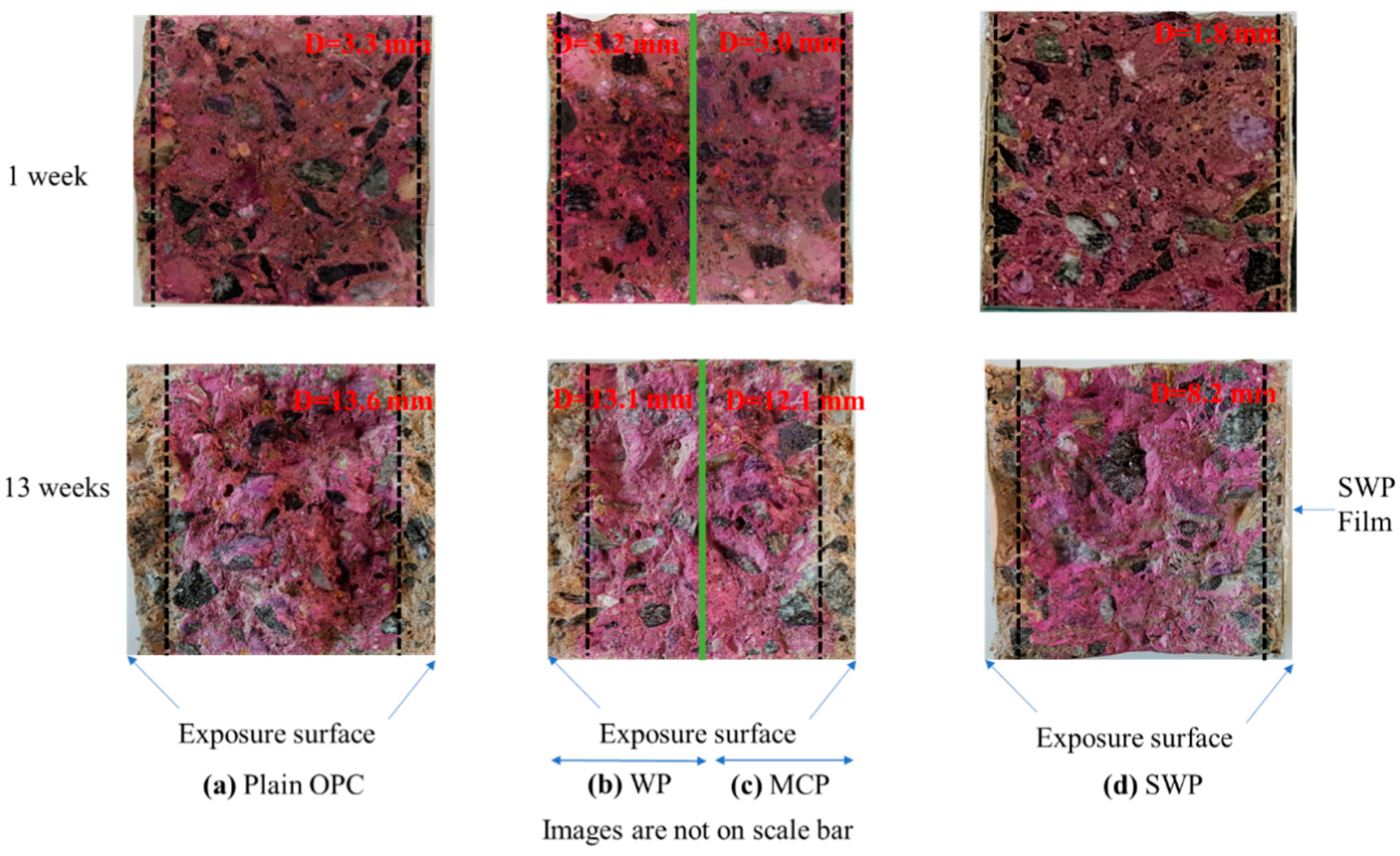
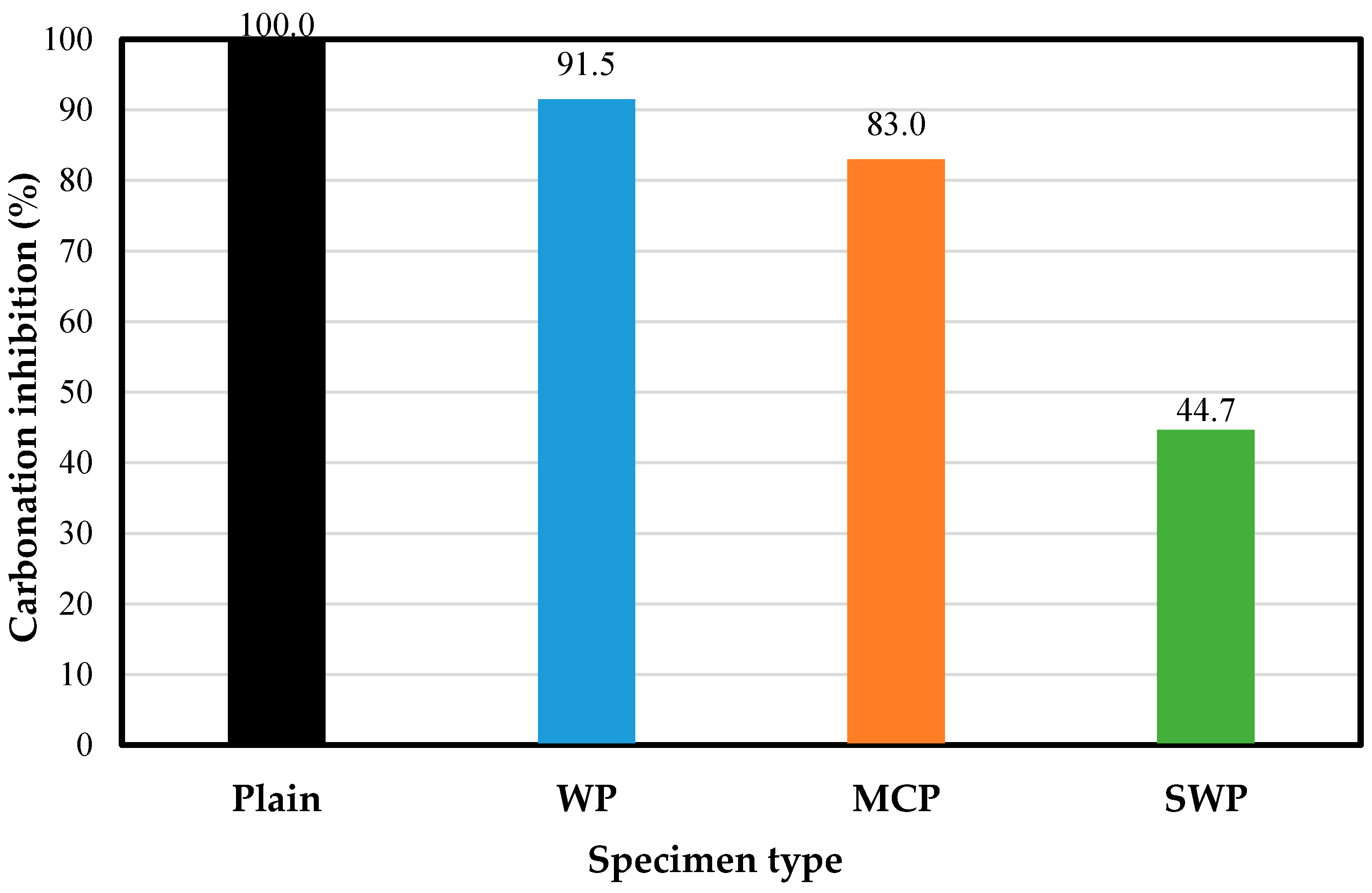
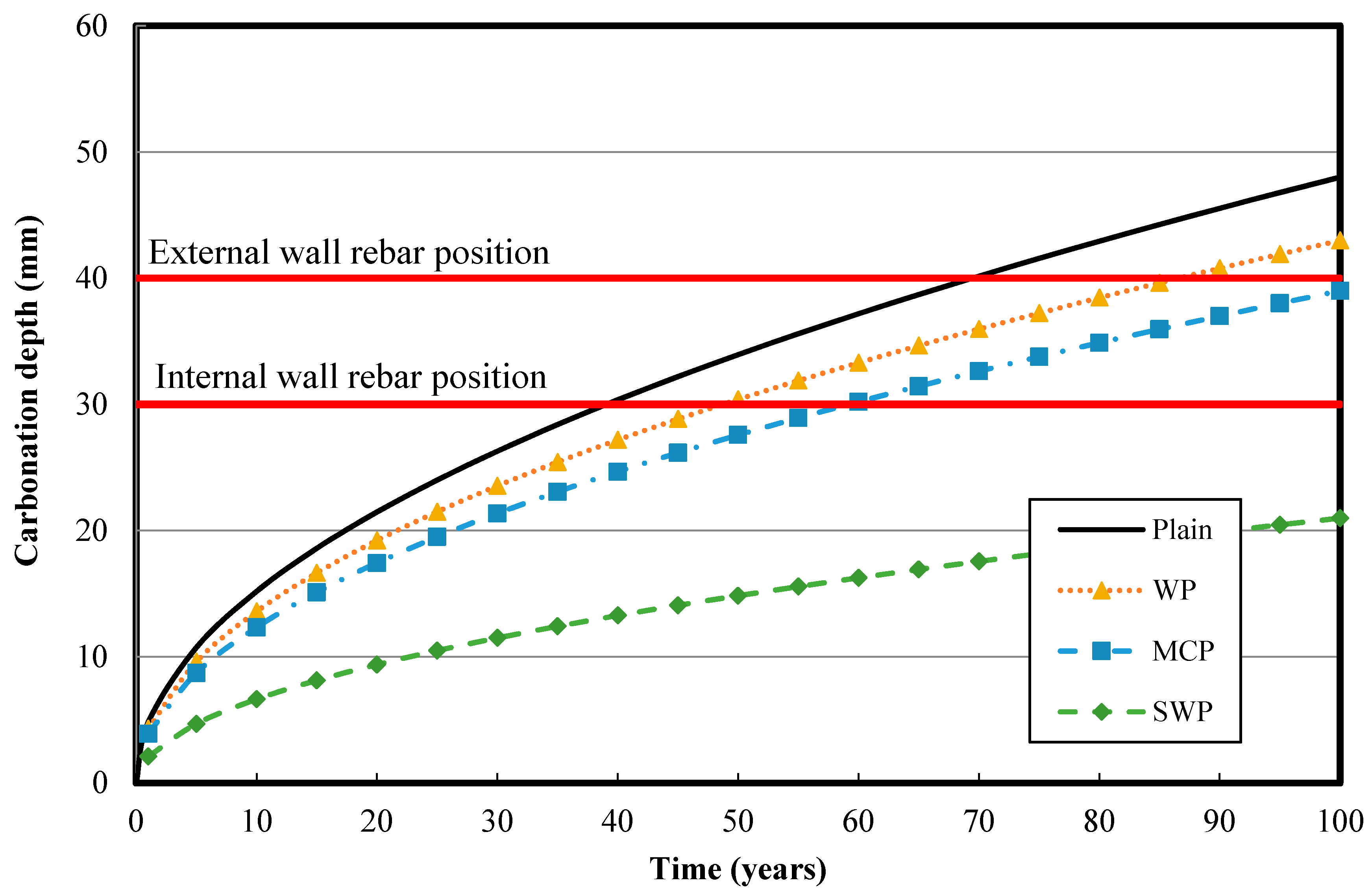
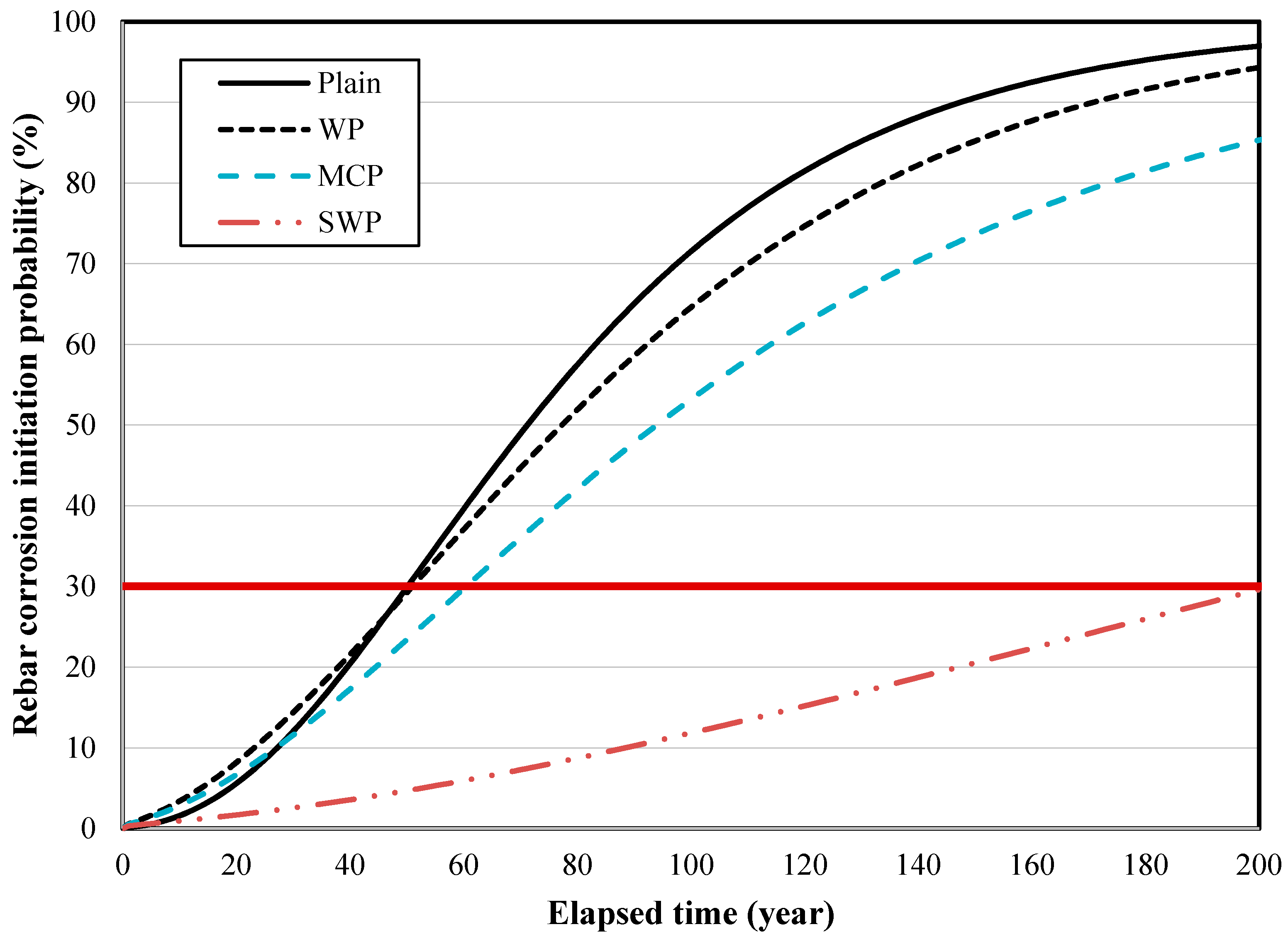
| Importance of the Building | Column, Beam, Primary Reinforcement | Other Rebars (Wall) | |
|---|---|---|---|
| Subject to Damage | Not Subject to Damage | ||
| Very important | 3% or less | 7% or less | 15% or less |
| Important | 5% or less | 15% or less | 30% or less |
| Normal | 10% or less | 30% or less | 50% or less |
| w/c (%) | Unit Weight (kg/m3) | Additive (%) | Compressive Strength | |||
|---|---|---|---|---|---|---|
| Water | Cement | Fine Aggregates | Coarse aggregate | (MPa) | ||
| 55 | 168 | 305 | 950 | 933 | 0.5 | 24 |
| Finishing Materials | Properties | Minimum Thickness on Surface (mm) | ||
|---|---|---|---|---|
| Color | Specific Gravity | pH | ||
| WP | white | 1.35 | 9 | 0.1 |
| MCP | black and white | 1 | 9 | 0.2 |
| SWP | White | - | - | 0.3 |
| Measurement Location | Mean Cover Thickness (mm) | Concrete Cover Thickness (mm) According to Korean Concrete Standard Specification [38] | ||
|---|---|---|---|---|
| Building A | Internal wall | Living room (SWP) | 35.8 | 30 (±10) |
| Laundry room (WP) | 37.5 | |||
| Staircase (MCP) | 40.3 | |||
| External wall | Rooftop | 50.0 | 40 (±10) | |
| Balcony | 48.3 | |||
| Building B | Internal wall | Living room (SWP) | 39.8 | 30 (±10) |
| Laundry room (WP) | 38.1 | |||
| Staircase (MCP) | 35.8 | |||
| External wall | Rooftop | 45.7 | 40 (±10) | |
| Balcony | 48.1 | |||
| Specimen Type | |||||
|---|---|---|---|---|---|
| 1 Week | 4 Weeks | 8 Weeks | 13 Weeks | Average | |
| Plain OPC | 0.52 | 0.49 | 0.46 | 0.42 | 0.47 |
| WP | 0.48 | 0.45 | 0.41 | 0.37 | 0.43 |
| MCP | 0.45 | 0.42 | 0.36 | 0.32 | 0.39 |
| SWP | 0.27 | 0.25 | 0.19 | 0.14 | 0.21 |
| Location | Cover Thickness Standard Deviation (mm) (σ) | Carbonation Depth Coefficient of Variation (ν) | |||
|---|---|---|---|---|---|
| External wall | Plain OPC | 48.03 | 13.8 | 40 | 0.25 |
| Internal wall | WP | 37.88 | 13.2 | 30 | 0.18 |
| MCP | 30 | 0.13 | |||
| SWP | 30 | 0.08 | |||
© 2018 by the authors. Licensee MDPI, Basel, Switzerland. This article is an open access article distributed under the terms and conditions of the Creative Commons Attribution (CC BY) license (http://creativecommons.org/licenses/by/4.0/).
Share and Cite
Lee, H.-M.; Lee, H.-S.; Min, S.-h.; Lim, S.; Singh, J.K. Carbonation-Induced Corrosion Initiation Probability of Rebars in Concrete With/Without Finishing Materials. Sustainability 2018, 10, 3814. https://doi.org/10.3390/su10103814
Lee H-M, Lee H-S, Min S-h, Lim S, Singh JK. Carbonation-Induced Corrosion Initiation Probability of Rebars in Concrete With/Without Finishing Materials. Sustainability. 2018; 10(10):3814. https://doi.org/10.3390/su10103814
Chicago/Turabian StyleLee, Hyung-Min, Han-Seung Lee, Sang-ho Min, Seungmin Lim, and Jitendra Kumar Singh. 2018. "Carbonation-Induced Corrosion Initiation Probability of Rebars in Concrete With/Without Finishing Materials" Sustainability 10, no. 10: 3814. https://doi.org/10.3390/su10103814
APA StyleLee, H.-M., Lee, H.-S., Min, S.-h., Lim, S., & Singh, J. K. (2018). Carbonation-Induced Corrosion Initiation Probability of Rebars in Concrete With/Without Finishing Materials. Sustainability, 10(10), 3814. https://doi.org/10.3390/su10103814







